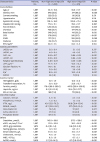INTRODUCTION
METHODS
Participants
Echocardiography
Measurement and definitions
Statistical analysis
Ethics statement
RESULTS
Table 1
Clinical characteristics according to the serum hepcidin status

Table 2
OR of cardiac geometry for high serum hepcidin

 | Fig. 1Relationship between RWT and serum hepcidin levels using generalized additive model plots. The Y-axis number indicates the difference from the mean serum hepcidin levels, and the dotted line indicates 95% CIs for the smoothed serum hepcidin levels. In the univariate model, the smoothing function for the association between RWT and serum hepcidin levels is displayed. In the multivariate model, covariates are left ventricular mass index, anemia markers (hemoglobin, ferritin, transferrin saturation, and administration of erythropoiesis stimulating agents or supplemental iron), bone mineral metabolism markers (serum levels of calcium, phosphorus, intact parathyroid hormone, and 25-hydroxyvitamin D and administration of oral vitamin D3, active vitamin D, and phosphate binder), and comorbidities (age, gender, smoking status, systolic and diastolic blood pressure, body mass index, fasting glucose, estimated glomerular filtration rate, urine protein to creatinine ratio, and serum levels of albumin and cholesterol), and inflammation (white blood cells and high sensitivity C-reactive protein).RWT = relative wall thickness, CI = confidence interval.
|
Table 3
Clinical characteristics according to the status of RWT

 | Fig. 2Subgroup analysis for the relationship between RWT and high serum hepcidin. Adjusted OR and 95% CI were analyzed using multivariate logistic regression analysis, entering into left ventricular mass index, anemia markers (Hb, ferritin, TSAT, and administration of erythropoiesis stimulating agents or supplemental iron), bone mineral metabolism markers (serum levels of calcium, P, iPTH, and 25-hydroxyvitamin D and administration of oral vitamin D3, active vitamin D, and phosphate binder), and comorbidities (age, gender, smoking status, systolic and diastolic blood pressure, body mass index, fasting glucose, eGFR, urine protein to creatinine ratio, and serum levels of albumin and cholesterol), and inflammation (white blood cells and hsCRP), and interaction term of RWT with gender and iPTH. Subgroups of age, Hb, TSAT, P, iPTH, hsCRP, and eGFR were categorized by the median values. When covariates were chosen as subgroup, they were excluded from the model.OR = odds ratio, CI = confidence interval, Hb = hemoglobin, TSAT = transferrin saturation, P = phosphorus, iPTH = intact parathyroid hormone, hsCRP = high sensitivity C-reactive protein, eGFR = estimated glomerular filtration rate, E/e′ = early diastolic mitral inflow to annulus velocity ratio, RWT = relative wall thickness.
|




 PDF
PDF Citation
Citation Print
Print




 XML Download
XML Download